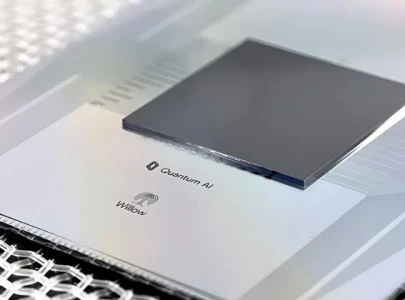

Google has unveiled its latest advancement in quantum computing: the Willow quantum chip. This breakthrough represents a major leap forward in the quest for large-scale, commercially viable quantum computers, continuing the company’s decade-long journey to harness quantum mechanics for practical applications.
A key challenge in quantum computing has always been minimizing errors caused by qubits.
These quantum units of computation are prone to exchanging information with their environment, resulting in data corruption and difficulties in performing accurate calculations.
Until recently, the more qubits were used, the higher the error rates became, often forcing the system to default to classical behavior.
However, Willow has achieved a remarkable breakthrough.
Google’s team has demonstrated that by using quantum error correction techniques, they were able to scale up the number of qubits in Willow without increasing error rates.
In fact, they reported an exponential reduction in errors as the system’s qubit grid expanded.
This is a milestone referred to as "below threshold," a long-awaited benchmark that indicates real progress in quantum error correction, first introduced by Peter Shor in 1995.
Additionally, Willow is one of the first quantum systems to implement real-time error correction, which is crucial for ensuring the integrity of calculations during computation.
This development brings Willow closer to being the first scalable quantum computer capable of useful, commercially relevant computations.
Willow has also shattered records in performance, surpassing one of the world’s most powerful classical supercomputers, Frontier, on the Random Circuit Sampling (RCS) benchmark.
This benchmark is used to assess whether a quantum computer can outperform classical machines on specific tasks, and it is considered the hardest benchmark currently available.
In an astonishing demonstration, Willow completed a computation in under five minutes that would take one of today’s fastest supercomputers 10 septillion years to perform — far beyond the age of the universe. This result further emphasizes the power of quantum computing and the growing potential of quantum processors to solve problems that are currently infeasible for classical machines.
The Willow chip was manufactured at Google’s advanced facility in Santa Barbara, designed specifically for quantum chip fabrication. The process ensures that all components of the chip are perfectly integrated for optimal performance, with particular attention given to the quality of qubits and system-wide engineering.
Willow boasts 105 qubits, with impressive T1 times, an indicator of how long qubits can retain information, now approaching 100 microseconds, an approximately five-fold improvement over previous generations.
Google’s long-term vision for Willow is to demonstrate a “useful, beyond-classical” quantum computation that is relevant to real-world applications.
While quantum systems have shown promise in solving scientifically interesting problems, the goal is to push past this and deliver algorithms that are not only beyond classical computation but also commercially applicable in sectors like drug discovery, energy storage, and optimization tasks crucial for AI development.
The Willow chip is part of Google’s larger Quantum AI initiative, and the company is optimistic that future advancements in quantum computing will significantly benefit fields like AI, medicine, energy, and beyond.
The roadmap towards practical quantum computing continues, and Willow is a significant step toward realizing the transformative potential of quantum technology.